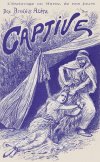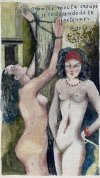With my first post in this thread, I would like to introduce you to the case of a special judicial murder in the late Middle Ages in Bavaria:
The drowning of Agnes Bernauer on October 12, 1435 near Straubing in the Danube
 Fall of the Agnes Bernauer into the Danube
Fall of the Agnes Bernauer into the Danube. Illustration from 1880. Illustration from: Joseph Maria Mayer, "Das Regentenhaus Wittelsbach, or: History of Bavaria, Regensburg 1880, 334"
 Agnes Bernauer is drowned in the Danube
Agnes Bernauer is drowned in the Danube: wood engraving, 1858, after a drawing by Wilhelm Camphausen (1808–1885). Berlin, Collection Archive for Art and History.

"
Agnes Bernauerin", the secret wife of Duke Albrecht III. v. Bavaria is drowned as a sorceress in the Danube near Straubing on October 12th, 1435, wood engraving around 1880
An eyewitness reported: On the orders of Duke Ernst of Bavaria, the beautiful mistress of his son Albrecht, the daughter of bathhouse owner in Augsburg, was thrown off the Straubing Danube bridge. She tried to swim to shore, but the hangman pushed her back under the water with a pole until she drowned.
Agnes Bernauer lived in Bavaria around the time of Joan of Arc (* 1410, + 1435). She was the daughter of a bathhouse owner in Augsburg. She was a beautiful, confident, and smart young woman, and that became her undoing. The Bavarian Crown Prince and future
Duke August III. from the Wittelsbach family fell in love with Agnes. But she not only accompanied him to the bathhouse and bedroom, she became his fiancé and from 1432 an influential person in the Bavarian court and lived with the crown prince from the beginning of 1433 at Blutenburg Castle. There is no evidence of a formal marriage.
Agnes Bernauer personally organized the arrest of the robber baron Münnhauser and aroused the ire of the Wittelsbach ducal family with her self-confident demeanour.
Duke Ernst, Albrecht's father, obviously could not accept the endangerment of the succession through the inappropriate marriage of his only son. While Albrecht was at a hunting event, he had Agnes insidiously arrested and drowned in the Danube near Straubing on October 12, 1435, accusing her of being a "wicked woman and sorceress" - there was no court hearing (pictures above).
A reconciliation between father and son and a befitting marriage to 'Anna von Braunschweig-Grubenhagen' in 1436 was only possible when Duke Ernst had built the Agnes Bernauer chapel in the St. Peter cemetery in Straubing, where it still stands today her tombstone is located. Indirectly, the father and duke thereby conceded the judicial murder he had ordered, because a Wittelsbach duke would not erect a chapel for a “wicked woman and sorceress”.
Even today, the Agnes Bernauer Festival is held every four years in Straubing (pictures below):
 Agnes Bernauer Chapel
Agnes Bernauer Chapel, coloured wood engraving from Johann Sporschils “
History of the Germans”, 1850
 Agnes Bernauer
Agnes Bernauer, contemporary portrait, along with her
tombstone and an actress from the Agnes Bernauer Festival 2007






















